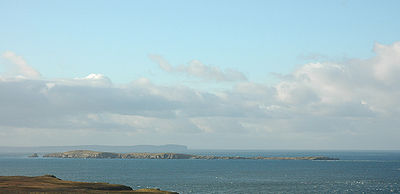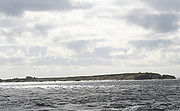
Swona
Encyclopedia

Pentland Firth
The Pentland Firth , which is actually more of a strait than a firth, separates the Orkney Islands from Caithness in the north of Scotland.-Etymology:...
off the north coast of Scotland
Scotland
Scotland is a country that is part of the United Kingdom. Occupying the northern third of the island of Great Britain, it shares a border with England to the south and is bounded by the North Sea to the east, the Atlantic Ocean to the north and west, and the North Channel and Irish Sea to the...
.
Geography and geology

Pentland Firth
The Pentland Firth , which is actually more of a strait than a firth, separates the Orkney Islands from Caithness in the north of Scotland.-Etymology:...
between the Orkney Islands
Orkney Islands
Orkney also known as the Orkney Islands , is an archipelago in northern Scotland, situated north of the coast of Caithness...
and Caithness
Caithness
Caithness is a registration county, lieutenancy area and historic local government area of Scotland. The name was used also for the earldom of Caithness and the Caithness constituency of the Parliament of the United Kingdom . Boundaries are not identical in all contexts, but the Caithness area is...
on the Scottish
Scotland
Scotland is a country that is part of the United Kingdom. Occupying the northern third of the island of Great Britain, it shares a border with England to the south and is bounded by the North Sea to the east, the Atlantic Ocean to the north and west, and the North Channel and Irish Sea to the...
mainland. It lies in the southern approach to Scapa Flow
Scapa Flow
right|thumb|Scapa Flow viewed from its eastern endScapa Flow is a body of water in the Orkney Islands, Scotland, United Kingdom, sheltered by the islands of Mainland, Graemsay, Burray, South Ronaldsay and Hoy. It is about...
, west of South Ronaldsay
South Ronaldsay
South Ronaldsay is one of the Orkney Islands off the north coast of Scotland. It is linked to the Orkney Mainland by the Churchill Barriers, running via Burray, Glimps Holm and Lamb Holm.-Geography and geology:...
.
Situated in the tidal stream of the Pentland Firth
Pentland Firth
The Pentland Firth , which is actually more of a strait than a firth, separates the Orkney Islands from Caithness in the north of Scotland.-Etymology:...
, a tidal race
Tidal race
Tidal race is a natural occurrence whereby a fast moving tide passes through a constriction resulting in the formation of waves, eddies and hazardous currents...
is present at both the north and south ends of the island, being minimal briefly at the turn of the tide. Between the races is a calm eddy which extends down-tide as the tide strengthens. The races are highly visible, with over-falls and whirlpool
Whirlpool
A whirlpool is a swirling body of water usually produced by ocean tides. The vast majority of whirlpools are not very powerful. More powerful ones are more properly termed maelstroms. Vortex is the proper term for any whirlpool that has a downdraft...
s. Large swell waves can also be present, especially in bad weather conditions. When entering or leaving the eddies crossing the races, even large powerful vessels can be pushed off course, such is the demarcation between the relatively calm eddy and the fast-moving tide in the races.
Swona is about 1.25 miles (2 km) long by about 0.5 mile (0.80467 km) wide, with a maximum height of approximately 41 metres (135 ft) and an area of about 92 hectare (0.355213985905132 sq mi). It is made up of Old Red Sandstone
Old Red Sandstone
The Old Red Sandstone is a British rock formation of considerable importance to early paleontology. For convenience the short version of the term, 'ORS' is often used in literature on the subject.-Sedimentology:...
with cliffs on the east coast.
It is administered as part of the Orkney Islands, while Stroma
Stroma, Scotland
Stroma is an island off the northern coast of the Scottish mainland. It is the more southerly of the two islands in the Pentland Firth between the Orkney Islands and Caithness. It is administratively part of Caithness , while its neighbour Swona, to the north, is part of the Orkney Islands...
, to the south, is part of the Highland Region (although traditionally part of Caithness). There is no regular access to the island, however, the ferry
Ferry
A ferry is a form of transportation, usually a boat, but sometimes a ship, used to carry primarily passengers, and sometimes vehicles and cargo as well, across a body of water. Most ferries operate on regular, frequent, return services...
from Gills Bay
Gills Bay
Gills Bay, which is situated some 3mls. West of John o' Groats with the community of Gills close by, has one of the longest stretches of low-lying rock coast on the northern shores of Caithness. Its main features are a small harbour and the pier used as the mainland terminal for Pentland Ferries...
, near John o' Groats
John o' Groats
John o' Groats is a village in the Highland council area of Scotland. Part of the county of Caithness, John o' Groats is popular with tourists because it is usually regarded as the most northerly settlement of mainland Great Britain, although this is not a claim made by the inhabitants...
, to St Margaret's Hope
St Margaret's Hope
St Margaret's Hope, known locally as The Hope , is a village in the Orkney Islands, situated off the north-east coast of Scotland. It has a population of about 550, making it Orkney's third largest settlement after Kirkwall and Stromness....
usually passes close to the island, dependent on the tidal direction at the time.
In 2005 Swona was owned by two Orkney farmers, but not worked due to difficulty of access. It is a SSSI (Site of Special Scientific Interest) conservation area
Conservation area
A conservation areas is a tract of land that has been awarded protected status in order to ensure that natural features, cultural heritage or biota are safeguarded...
with a number of rare plants.
History
The island takes its name from Old Norse, Svíney or Swefney, meaning either "Swine Isle" or "Sweyn’s Isle".There is a similarly named island, Svínoy
Svínoy
Svínoy is an island located in the north-east of the Faroe Islands, to the east of Borðoy and Viðoy. It is divided into two unequally sized peninsulas. The island takes its name from Old Norse, Svíney, meaning "Swine Isle"...
, in the Faroe Islands
Faroe Islands
The Faroe Islands are an island group situated between the Norwegian Sea and the North Atlantic Ocean, approximately halfway between Scotland and Iceland. The Faroe Islands are a self-governing territory within the Kingdom of Denmark, along with Denmark proper and Greenland...
.
There are prehistoric, pre-Norse and Norse remains on the island. as well as the remains of more recent crofting settlement including a herd of feral cattle. The island was populated from around 500 BC until 1974.
Boats were built on the island for a number of years. The last of these, the Hood can be seen pulled well up the shingle beach by the landing stage. It is no longer seaworthy, having a hole in it caused by the feral cows using it as a rubbing post. The landing stage and boat can be seen briefly in passing through a gap in the rocks near the north end of the island on the east side. The last house to be occupied can also be seen in this area.
The island was the site of many shipwreck
Shipwreck
A shipwreck is what remains of a ship that has wrecked, either sunk or beached. Whatever the cause, a sunken ship or a wrecked ship is a physical example of the event: this explains why the two concepts are often overlapping in English....
s caused by the strong currents in the Pentland Firth. In 1931, a 6,000 ton Danish freighter called Pennsylvania was wrecked on the island. The Orkney newspaper of the time said that it was one of the most richly-laden ships that was ever wrecked in the area. After some salvaging, the wreck was finally bought by a syndicate of Stroma and Swona men.
The Swona Minor light was built in 1906 on the south west tip of Swona. It was originally a cast iron tower but was replaced by a reinforced concrete square tower sometime in the 1980s. The earlier Stroma Lighthouse was built in 1896 and stands at the northern end of Stroma island.
In summer 1973 Arthur Rosie left the island and died shortly afterwards. James and Violet Rosie (brother and sister) left in March 1974. James had Parkinsons Disease and died c. 1976 of a perforated stomach ulcer. Violet died c. 1984 in South Ronaldsay. They did not return to the island after they left it. Many of the houses, while in a state of dilapidation, are as they were left, with various possessions still to be seen where they were abandoned.
Wildlife
When the population departed they left a herd of beef cattle - 8 cows and 1 bull (ShorthornShorthorn
The Shorthorn breed of cattle originated in the North East of England in the late 18th century. The breed was developed as dual purpose, suitable for both dairy and beef production; however there were always certain blood lines within the breed which emphasised one quality or the other...
- Aberdeen-Angus cross). Five generations later, in 2004, the herd which had turned feral
Feral
A feral organism is one that has changed from being domesticated to being wild or untamed. In the case of plants it is a movement from cultivated to uncultivated or controlled to volunteer. The introduction of feral animals or plants to their non-native regions, like any introduced species, may...
was still going strong, and is now classified as a new breed. It then consisted of ten bulls, four cows, and two calves. This appears to be around the maximum number that the island can support. Two calves are born each spring, although not all live to maturity. The herd gets no additional feed, although it is checked by a vet each year. The animals are self-selecting for hardiness, easy calving, and low-maintenance, feeding off the grass and seaweed. Having been separated from the mainland for so long, they are completely disease-free, and have reverted to wild behaviour. Because of this, DNA
DNA
Deoxyribonucleic acid is a nucleic acid that contains the genetic instructions used in the development and functioning of all known living organisms . The DNA segments that carry this genetic information are called genes, but other DNA sequences have structural purposes, or are involved in...
samples have been taken, from the ears of some of the cattle that died. In the summer the main herd is usually in the centre of the island.

